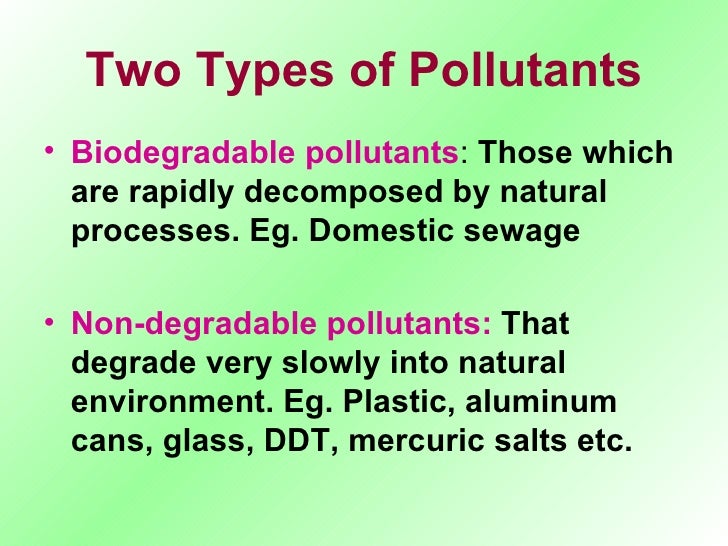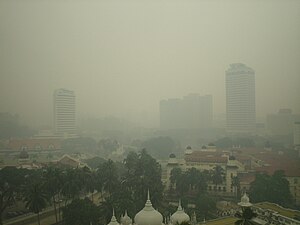Air Pollutants

Primary Pollutants: Persist in the form in which they are added to the environment for ex. DDT, Plastic
Secondary Pollutants: Formed by interaction among primary pollutants viz. PAN by interaction of NOx & Hydrocarbons
Biodegradable Pollutants: Waste products which are degraded by microbial action for ex. Sewage

Non-Biodegradable Pollutants: Not decomposed by microbial action for ex. Plastic, Glass, DDT, Radioactive substances

Non-Biodegradable Pollutants: Not decomposed by microbial action for ex. Plastic, Glass, DDT, Radioactive substances
Quantitative Pollutants: Occur in nature & become pollutant when their concentration reaches beyond a threshold level for ex. CO2, NOx
Qualitative Pollutants: Do not occur in nature & are man-made for ex. fungicides, herbicides, DDT
Major Air Pollutants
1. CO
By incomplete combustion of carbon based fuels, Automobile exhaust, Cigarette smoke
Combines with hemoglobin to form carboxyhaemoglobin, which is highly stable & reduces oxygen carrying capacity of blood
Slow our reflexes & make us confused & sleepy
2. CO2
Major greenhouse gas formed by respiration, burning of fuels, decomposition of lime, volcanic eruption


3. CFCs
- Released mainly from air conditioning systems & refrigeration
- Detrimental to Ozone layer present in the stratosphere as CFC + UV >> Cl (Chlorine radicals which causes breakdown of Ozone)

4. Lead
- Present in petrol, diesel, lead batteries, paints, hair dye products etc. (Affects children in particular)
- Damages nervous system & cause digestive problems & in some cases causes cancer
5. O3
- Formed when NOx particle from vehicle exhaust & volatile Hydrocarbons interact with each other in presence of sunlight
6. SPM
- SPMs in air, when breathed in causes lung damage & respiratory problems
7. SO2
- Produced from burning coal (60 %), mainly in thermal power plants + Petroleum products + in production of paper & smelting of metals .
- Major contributor to smog causing lung diseases

8. CH4
- Mainly CH4 burns in fossil fuels + produced by burning of vegetation / rotting
9. Acid Rain
- Ph< 5.6 (Rain with oxides of sulphur & nitrogen (SO2 & NO2)) – HNO3 + H2SO4

10. NOx
- NO3- → Acts as a fertilizer to the soil
- Automobile exhaust produces NO2 which damages plant leaves & retard rate of photosynthesis + also causes red haze & lung irritation
11. Classical Smog
- Occurs in cool humid climate .
- Chemically reducing hence called reducing smog
- Smoke + fog + SO2
4_0.jpg?itok=amZIuS_3)
12. Photochemical Smog
- Occurs in warm, dry & sunny climate
- Result from the action of sunlight on unsaturated HC & NOx produced by factories & automobile

- Chemically oxidising hence called oxidising smog Ozone + Acrolein + Formaldehyde + Peroxyacetyl Nitrate (PAN) are produced which cause serious health problems, severe plant damage, cracking of rubber & corrosion Catalytic Converter – Prevent release of NO & HC to environment.
13. GHGs
- CO2, CH4, CFC, N2O, SF6, HFCs, PFCs, CCl4, CH3CCl3, Water Vapour, O3

14. Formaldehyde
- Mainly from carpets, particle boards & insulation foam → Causes irritation & allergies
15. Radon
- A gas naturally emitted by soil .Due to poor ventilation it is confined inside house & causes lung cancer
ALL THE BEST
